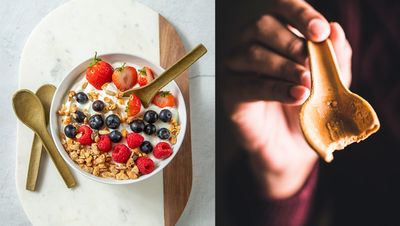Sure, you may bring a reusable straw when you go out to eat. But what about digesting your silverware at the restaurant? The future is already here.
Edible cutlery feels like a natural progression post-reusable straw.
Air New Zealand just added the new edible coffee cup Twiice into their in-flight service. Made from vanilla, wheat flower, sugar, egg and vanilla essence, the Twiice cups will be standard issue for the international airline.
On the ground, the new, award-winning startup IncrEDIBLESpoon has shipped more than a quarter million edible scoopers. The spoons are all-natural, vegan, and made from wheat, oat, corn, chickpea and barley.
The technological breakthrough is in creating tasty, mass-market material durable enough for delivery in an assembly line environment like airplane service, as well as stable enough to hold a hot cup of coffee or a freezing scoop of ice cream. Twiice cups can last several hours after hot coffee is added, while IncrEDIBLESpoon cutlery holds up to 45 minutes.
"We already caught the interest of a couple major ice cream chains," says Dinesh Tadepalli, co-founder of the IncrEDIBLESpoon parent company Planeteer. "If all goes well, one of them will test out our spoons at their scoop shop early this year."
Next Up
Edible cutlery feels like a natural progression post-reusable straw. And more is already on the menu.
The coffee cup company Twiice is already planning on expanding. Co-founder Jamie Cashmore says other serving items are coming later this year.
IncrEDIBLESpoon is also getting into more utensils. "We plan to mass produce the complete set by year's end: Edible straws, edible forks and edible coffee stirrers," Tadepalli says.
Most notably, Twiice's partner Air New Zealand sees the coffee cup as just a start to other sustainable solutions. The airline estimates it currently serves eight million cups of coffee annually. It's even suggesting customers bring their own reusable cup to the plane – though that isn't as ergonomic nor as attractive as eating everything you are served.
Open Questions
Making everything edible has a few challenges. First is cultural acceptance: With respect to current success, changing eating habits will require going beyond eco-focused and curious eaters.
Second, it's unclear if the short-term economics will add up in favor of airline carriers and other companies. Like alternative fuel, organizations will be more likely to adopt new science when it doesn't require a retrofitting or expensive change to their current business model – even if it does create long-term benefits.
The changes will likely be lopsided, influencing cultures at different times. Airplanes are a great start, as passengers are a captive audience interested in removing waste as soon as possible.
"Imagine eating a black pepper spoon after your soup or a chocolate spoon after your ice cream?"
We can expect edible cutlery to make an easier impact with certain cultures or foods. For instance, injera, the spongy Ethiopian bread, has served as an African plate of sorts for years. It makes sense that IncrEDIBLESpoon's four flavors, Salt, Masala, Spinach and Root, all fit in another bread-as-plate friendly culture: Indian.
Coffee and desserts sound like a good bet for now, though, especially for foodies. "People are curious to try edible spoons as they never heard or experienced them before," Tadepalli says. "Imagine eating a black pepper spoon after your soup or a chocolate spoon after your ice cream?"
